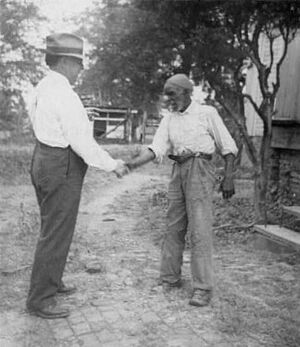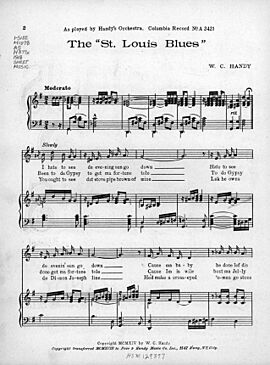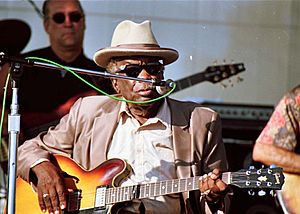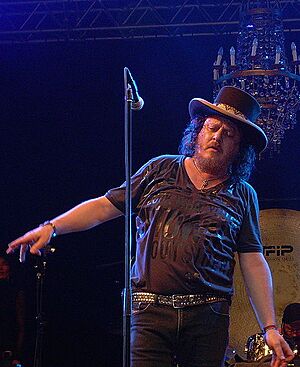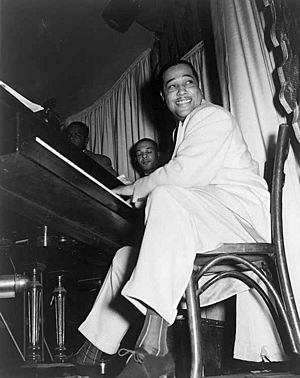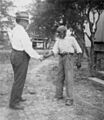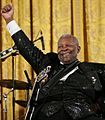Blues facts for kids
Quick facts for kids Blues |
|
|---|---|
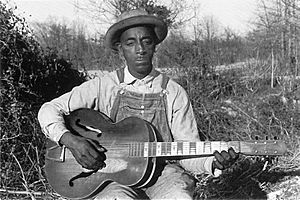
American blues musician Mississippi Fred McDowell in 1960
|
|
| Stylistic origins |
|
| Cultural origins | 1860s, Deep South, U.S. |
| Derivative forms | |
| Subgenres | |
|
Subgenres
|
|
| Fusion genres | |
|
Fusion genres
|
|
| Regional scenes | |
|
Regional scenes
|
|
| Other topics | |
|
|
Blues is a type of music and musical form that started with African-Americans in the Deep South of the United States around the 1860s. Blues music grew from different sounds like spirituals (religious songs), work songs (songs sung while working), and rhymed ballads (story songs) from African-American culture.
Blues music is very important in jazz, rhythm and blues, and rock and roll. It often uses a "call-and-response" pattern, where one musical phrase is answered by another. It also uses a special blues scale and certain chord progressions, like the twelve-bar blues, which is the most common. "Blue notes" are also a key part of the blues sound. These notes are played a little flatter than usual. Blues "shuffles" or "walking bass" lines create a steady, repeating rhythm called a "groove".
Early blues songs often told a story. They talked about the challenges and difficulties that African-Americans faced. Many parts of the blues, like the call-and-response style and blue notes, came from music of Africa. The blues also has strong ties to the religious music of the Afro-American community, called spirituals. Blues music started to appear more after slavery ended. People began to write about blues music around the early 1900s. The first blues sheet music was published in 1908. Since then, blues has grown from simple singing to many different styles.
Contents
What Does "Blues" Mean?
The word "Blues" might come from "blue devils," which means feeling sad or down. An early use of this idea was in a play called Blue Devils in 1798. Over time, the phrase "the blues" came to mean a feeling of sadness or worry.
In 1827, John James Audubon wrote to his wife that he "had the blues," meaning he felt sad. Later, in 1862, a schoolteacher named Charlotte Forten Grimké wrote in her diary that she "came home with the blues" because she felt lonely. She noted that songs popular among enslaved people "can't be sung without a full heart and a troubled spirit." These feelings have inspired countless blues songs.
The phrase "the blues" has been used in African-American music since at least 1912. That's when Hart Wand's "Dallas Blues" became the first blues song to be officially copyrighted. In song lyrics, the phrase often describes a sad mood.
Blues Song Lyrics

Early blues songs often had a single line repeated four times. But the most common way blues lyrics are structured today is called the "AAB" pattern. This pattern became popular in the early 1900s. It means one line is sung, then repeated, and then a different, longer line finishes the thought. You can hear this in early blues songs like "Dallas Blues" (1912) and "Saint Louis Blues" (1914). This pattern helped make the songs less repetitive. Sometimes, the lyrics are sung in a rhythmic, talking style, like a "talking blues."
Early blues often told stories about the difficulties people faced. African-American singers shared their "personal woes in a world of harsh reality." This included stories about lost love or hard times.
For example, Blind Lemon Jefferson's "Rising High Water Blues" (1927) talks about the Great Mississippi Flood of 1927:
Backwater rising, Southern peoples can't make no time
I said, backwater rising, Southern peoples can't make no time
And I can't get no hearing from that Memphis girl of mine
Even though blues is linked to sadness, the lyrics could also be funny. Hokum blues, for instance, was known for its funny lyrics and lively, playful performances. After World War II, blues lyrics often focused on relationship problems. Themes like economic hardship or farming were less common in later blues.
Many early blues artists, like Charley Patton and Skip James, also sang religious songs or spirituals. Artists like Reverend Gary Davis and Blind Willie Johnson are often called blues musicians, even though their lyrics were clearly spiritual.
How Blues Music is Structured
The blues form is a repeating musical pattern. It uses a series of chords that match the "call and response" style found in African and African-American music. In the early 1900s, blues music didn't have a strict chord pattern. But as artists like Bessie Smith became popular, the twelve-bar blues became the standard in the 1920s and 1930s.
Other chord patterns, like 8-bar or 16-bar forms, are also considered blues. Examples include "How Long Blues" (8-bar) and Ray Charles's "Sweet 16 Bars" (16-bar). Sometimes, unusual numbers of bars are used, like the 9-bar pattern in "Sitting on Top of the World".
| Chords played over a 12-bar scheme: | Chords for a blues in C: | ||||||||||||||||||||||||
|
|
The basic 12-bar structure of many blues songs is shown by a standard pattern of 12 bars in 4/4 time. The blues chords for a twelve-bar blues are usually three different chords played over the 12-bar pattern. They are named using Roman numerals based on their position in the musical key. For example, in the key of C, C is the main chord (I), and F is the subdominant (IV).
The last chord is often a "dominant" chord that leads back to the start of the next pattern. The singing usually ends on the tenth or eleventh bar, leaving the last two bars for the instruments to play a short solo or "break."
Often, some or all of these chords are played as "harmonic seventh" (7th) chords. This "blues seven" sound is a key part of blues music.
In the melody, blues music often uses "flattened" notes, especially the third, fifth, and seventh notes of the main musical scale. These are the "blue notes."
Blues "shuffles" or "walking bass" lines make the rhythm strong and repeating, creating a "groove." These shuffles have been important in blues since its early days and were also key in swing music. A simple shuffle might be a three-note riff played on the lower strings of a guitar. When played with bass and drums, it creates that special blues "feel." Shuffle rhythm sounds like "dow, da dow, da dow, da." It uses uneven, or "swung," eighth notes.
History of Blues Music
Early Blues Origins
Hart Wand's "Dallas Blues" was published in 1912, and W.C. Handy's "The Memphis Blues" came out the same year. The first recording by an African American singer was Mamie Smith's "Crazy Blues" in 1920. But blues music actually started decades earlier, probably around 1890. This early music isn't well documented because of racial issues and because many rural African Americans couldn't read or write at the time.
Reports of blues music in southern Texas and the Deep South appeared around the early 1900s. People like Charles Peabody and Gate Thomas mentioned hearing blues in Mississippi and Texas. These reports match what early musicians remembered. Jelly Roll Morton said he first heard blues in New Orleans in 1902. Ma Rainey heard it in Missouri the same year, and W. C. Handy in Mississippi in 1903.
Early recordings of blues music were made for research, but many are now lost. Later, in the 1930s, John Lomax and his son Alan Lomax made many non-commercial blues recordings. These show how varied early blues styles were, including field hollers (shouts from workers) and ring shouts (group singing and dancing). Recordings by artists like Lead Belly and Henry Thomas also show what blues music was like before 1920. These recordings reveal many different blues structures, not just the 12-bar form.
The social and economic reasons for blues music appearing are not fully known. It usually dates to after the Emancipation Proclamation of 1863, between the 1860s and 1890s. This was a time when formerly enslaved people gained freedom. It also saw the rise of juke joints, places where African-Americans could listen to music and dance after work. This period also saw changes from slavery to sharecropping (farming for a share of the crops) and the growth of railroads in the South.
Some scholars believe that blues music developed as people moved from group performances to individual ones. They think the blues is linked to the new freedom that formerly enslaved people gained.
There are few things that are true for all blues music, because it changed a lot with each performer. But some things were present long before modern blues. "Call-and-response" shouts were an early form of blues-like music. These were "functional expressions" without instruments or harmony. They grew from slave ring shouts and field hollers into "simple solo songs full of emotion."
Blues music grew from the singing and traditions of enslaved people from West Africa and rural Black Americans. It became many different styles and subgenres across the United States. While blues uses European harmonic structure and African call-and-response, the blues form itself is different from the music of West African griots (storytellers and musicians). Some theories suggest the four-beats-per-measure structure of blues might come from Native American pow wow drumming.
No single African musical form is the direct ancestor of the blues. However, the call-and-response style comes from music of Africa. The use of "blue notes" also existed in African music before the blues.
Instruments like the Diddley bow (a homemade one-string instrument) and the banjo came from Africa. They may have helped bring African playing styles into early blues. The banjo is similar to instruments played by African peoples like the Wolof and Mandinka. However, by the 1920s, the banjo was not very common in blues music.
Blues music also took ideas from "Ethiopian airs," minstrel shows, and Negro spirituals, including how instruments were used. The style was also close to ragtime, which developed at the same time. But blues kept more of the "original melodic patterns of African music."
Blues and modern country music both started in the same parts of the southern United States in the 1800s. In the 1920s, record companies created categories like "race music" for Black artists and "hillbilly music" for white artists. At that time, there wasn't a clear musical difference between "blues" and "country," except for the performer's background.
Music experts now try to define blues by its chord structures and lyric forms. But audiences first heard it more generally as the music of the rural South, especially the Mississippi Delta. Black and white musicians often shared the same songs. The idea of "blues" as a separate type of music grew during the black migration to cities in the 1920s. It also grew as the recording industry developed. "Blues" became a term for records made for Black listeners.
The origins of the blues are closely linked to the religious music of the Afro-American community, the spirituals. Spirituals started much earlier, around the mid-1700s, when enslaved people began to sing Christian hymns. Before blues had its formal musical definition, it was seen as the non-religious version of spirituals. It was the "low-down" music played by rural Black people.
Some religious communities saw playing this "low-down" music as a sin. So, musicians were sometimes separated into gospel singers and blues singers. But when rural Black music was recorded in the 1920s, both types of musicians used similar techniques: call-and-response, blue notes, and slide guitars. Gospel music, however, used musical forms that fit Christian hymns more than the blues form.
Blues Before World War II
The American sheet music industry produced a lot of ragtime music. By 1912, three popular blues-like songs were published: "Baby Seals' Blues," "Dallas Blues," and "The Memphis Blues" by W.C. Handy.
Handy was a trained musician and composer. He helped make the blues popular by writing it down and arranging it for bands and singers. He became a famous composer and called himself the "Father of the Blues." His songs mixed blues with ragtime and jazz. Handy's most famous work was the "Saint Louis Blues."
In the 1920s, blues became a big part of African American and American popular music. It also reached white audiences through Handy's arrangements and female blues singers. These female singers were some of the first African American "superstars." Their record sales showed a huge demand for music made by and for Black people. Blues performances moved from informal bars to theaters. Record companies like American Record Corporation and Okeh Records started recording African-American music.
As the recording industry grew, country blues artists like Blind Lemon Jefferson and Lonnie Johnson became more popular. Sylvester Weaver was the first to record the slide guitar style in 1923. This style, where a guitar is played with a slide, became important in Delta blues. Early blues recordings from the 1920s are divided into traditional, rural country blues and more polished city or urban blues.
Country blues artists often made up their music on the spot, sometimes just with a banjo or guitar. Regional styles of country blues were very different. The (Mississippi) Delta blues was a raw, simple style with strong singing and slide guitar. Robert Johnson combined city and country blues. Other important Delta blues artists included Charley Patton and Son House. Singers like Blind Willie McTell played in the "Piedmont blues" style, which used a fancy fingerpicking guitar technique based on ragtime.
The lively Memphis blues style developed in the 1920s and 1930s near Memphis, Tennessee. It was influenced by jug bands. Artists like Memphis Minnie were known for their amazing guitar playing. Many Memphis blues musicians moved to Chicago in the late 1930s or early 1940s and became part of the urban blues scene.
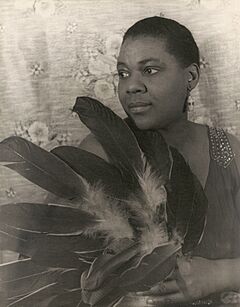
City Blues
City or urban blues styles were more organized and detailed. Singers had to adapt to larger, more varied audiences. Classic female urban and vaudeville blues singers were popular in the 1920s, including "the big three": Gertrude "Ma" Rainey, Bessie Smith, and Lucille Bogan. Mamie Smith was the first African American to record a blues song in 1920. Her second record, "Crazy Blues," sold 75,000 copies in its first month. These recordings were often called "race records" to show they were for Black audiences. However, some white buyers also bought them. These blueswomen helped change popular singing styles, influencing jazz, Broadway musicals, gospel, and rhythm and blues.
Male urban blues artists included Tampa Red, Big Bill Broonzy, and Leroy Carr. An important record label was Chicago-based Bluebird Records. Before World War II, Tampa Red was called "the Guitar Wizard." Carr played piano with Scrapper Blackwell on guitar, a style that continued into the 1950s.
Boogie-woogie was another important style of urban blues in the 1930s and early 1940s. It's often linked to solo piano, but it was also used with singers and in bands. Boogie-woogie is known for a steady bass line, a repeating musical idea (or riff), and fancy playing in the right hand. Jimmy Yancey and the Boogie-Woogie Trio (Albert Ammons, Pete Johnson, and Meade Lux Lewis) were pioneers of this style.
Another development was big band blues. Bands from Kansas City, like the Count Basie Orchestra, focused on the blues. They played 12-bar blues instrumental songs and had strong "blues shouting" singers like Jimmy Rushing. In the 1940s, the jump blues style developed. Jump blues grew from boogie-woogie and was influenced by big band music. It used saxophones or other brass instruments and guitar to create a jazzy, fast sound with powerful singing. Jump blues songs by Louis Jordan and Big Joe Turner influenced later styles like rock and roll and rhythm and blues. T-Bone Walker from Dallas, often linked to the California blues style, helped bridge early urban blues to jump blues.
Blues in the 1950s
The move from country blues to urban blues, which started in the 1920s, was sped up by people moving from farms to cities. This was called the Great Migration. After World War II, another big move happened, the Second Great Migration. This brought more Black people to cities and increased their income. This new group of people created a new market for music. The term "race record" for African-American music was replaced by "rhythm and blues" (R&B). This change led to more electric instruments and amplification in urban blues. The blues beat, or blues shuffle, became very common in R&B. Blues, along with jazz and gospel music, became a key part of R&B.
After World War II, new styles of electric blues became popular in cities like Chicago and Memphis. Electric blues used electric guitars, double bass (later bass guitar), drums, and harmonica played through microphones and amplifiers. Chicago became a center for electric blues from 1948, when Muddy Waters recorded his first hit. Chicago blues was heavily influenced by Delta blues, as many musicians had moved from Mississippi.
Howlin' Wolf, Muddy Waters, Willie Dixon, and Jimmy Reed were all born in Mississippi and moved to Chicago. Their style used electric guitar (sometimes slide guitar), harmonica, and a rhythm section. Little Walter, Sonny Boy Williamson, and Sonny Terry were famous harmonica players in early Chicago blues. Muddy Waters and Elmore James were known for their new ways of using slide electric guitar. Howlin' Wolf and Muddy Waters had deep, rough voices.
The bassist and songwriter Willie Dixon was very important in Chicago blues. He wrote many standard blues songs, like "Wang Dang Doodle" for Howlin' Wolf. Most Chicago blues artists recorded for Chess Records and Checker Records. In the early 1950s, Sam Phillips' Sun Records in Memphis recorded B. B. King and Howlin' Wolf. After Phillips discovered Elvis Presley in 1954, Sun Records focused on rock 'n' roll for a white audience.
In the 1950s, blues had a huge impact on popular American music. Musicians like Bo Diddley and Chuck Berry, who recorded for Chess, were influenced by Chicago blues. Their energetic styles were different from the sadder parts of blues. Chicago blues also influenced Louisiana's zydeco music.
In England, electric blues became popular after a Muddy Waters tour in 1958. Waters played his loud electric blues, which surprised the audience but inspired local musicians like Alexis Korner and Cyril Davies. This helped lead to the British Invasion bands like The Rolling Stones and The Yardbirds.
In the late 1950s, a new blues style appeared on Chicago's West Side. It was started by Magic Sam, Buddy Guy, and Otis Rush. This "West Side sound" had strong rhythm from guitar, bass, and drums. It was known for powerful electric lead guitar solos.
Other blues artists, like John Lee Hooker, had unique styles not directly linked to Chicago blues. John Lee Hooker's blues was more "personal," with his deep voice and a single electric guitar. His "groovy" style is sometimes called "guitar boogie." His first hit, "Boogie Chillen," reached number 1 on the R&B charts in 1949.
By the late 1950s, the swamp blues genre developed near Baton Rouge. Artists like Lightnin' Slim and Slim Harpo were part of this style. Swamp blues is slower and uses the harmonica more simply than Chicago blues. Songs from this style include "Scratch my Back" and "I'm a King Bee."
Blues in the 1960s and 1970s
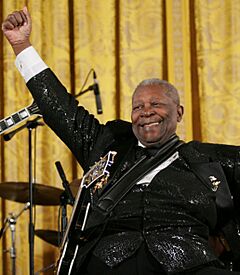
By the early 1960s, music influenced by African American music, like rock and roll and soul, was very popular. White artists like the Rolling Stones and the Beatles introduced African-American music to new audiences around the world. However, the blues wave that brought artists like Muddy Waters to fame had slowed down. Blues musicians like Big Bill Broonzy and Willie Dixon started looking for new audiences in Europe. Blues festivals in Europe helped spread blues music abroad. In the UK, bands copied U.S. blues legends, and UK blues rock bands were very influential in the 1960s.
Blues artists like John Lee Hooker and Muddy Waters continued to perform to excited crowds. They inspired new artists who loved traditional blues, like Taj Mahal. John Lee Hooker mixed his blues style with rock elements, playing with younger white musicians. B. B. King's singing and amazing guitar playing earned him the title "king of the blues." King created a smooth guitar solo style with fluid string bending and shimmering vibrato. Unlike the Chicago style, King's band used strong brass instruments like saxophone and trumpet instead of slide guitar or harmonica. Bobby "Blue" Bland also played both blues and R&B. During this time, Freddie King and Albert King often played with rock and soul musicians and greatly influenced those styles.
The Civil Rights Movement in the U.S. led to new interest in American roots music and early African American music. Festivals like the Newport Folk Festival brought traditional blues to new audiences. This helped revive interest in acoustic blues from before the war and artists like Son House and Mississippi John Hurt. Many collections of classic pre-war blues were re-released. J. B. Lenoir from the Chicago blues scene recorded albums using acoustic guitar. His songs, first released in Europe, sometimes commented on social issues.
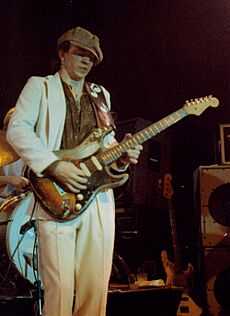
White audiences became more interested in the blues in the 1960s because of bands like the Chicago-based Paul Butterfield Blues Band and the British blues movement. British blues developed in the UK, with musicians like Cyril Davies and bands like Fleetwood Mac, John Mayall & the Bluesbreakers, The Rolling Stones, and Cream playing classic blues songs.
In 1963, Amiri Baraka wrote Blues People: The Negro Music in White America, the first book on the social history of the blues. British and blues musicians of the early 1960s inspired many American blues rock artists, including Canned Heat and Janis Joplin. One blues rock artist, Jimi Hendrix, was unique as a Black man who played psychedelic rock. Hendrix was a skilled guitarist and a pioneer in using distortion and audio feedback in his music. Through these artists, blues music influenced the growth of rock music. Later in the 1960s, British singer Jo Ann Kelly started her career. In the US, from the 1970s, female singers Bonnie Raitt and Phoebe Snow performed blues.
In the early 1970s, the Texas rock-blues style appeared. It used guitars for both solo and rhythm parts. Unlike West Side blues, the Texas style was strongly influenced by British rock-blues. Major artists of this style include Johnny Winter, Stevie Ray Vaughan, and ZZ Top. These artists started in the 1970s but became internationally famous in the 1980s.
Blues from the 1980s to Today
Since the 1980s, there's been new interest in the blues among some African-Americans, especially around Jackson, Mississippi. This music, often called "soul blues" or "Southern soul," got a boost from the success of two recordings on the Malaco label: Z. Z. Hill's Down Home Blues (1982) and Little Milton's The Blues is Alright (1984). Today, African-American artists like Bobby Rush and Denise LaSalle work in this style.
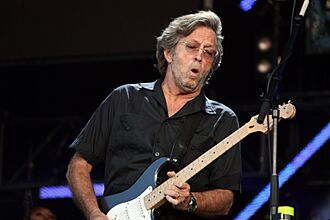
In the 1980s, blues continued in both traditional and new ways. In 1986, the album Strong Persuader made Robert Cray a major blues artist. The first Stevie Ray Vaughan album, Texas Flood, came out in 1983, and he became famous worldwide. John Lee Hooker's popularity returned with the album The Healer in 1989. Eric Clapton, known for his work with the Blues Breakers and Cream, made a comeback in the 1990s with his album Unplugged, where he played acoustic blues songs.
However, starting in the 1990s, new recording technology and marketing strategies increased costs. This made it harder for the spontaneous and improvised parts of blues music. In the 1980s and 1990s, blues magazines like Living Blues were started. Cities began forming blues societies, outdoor blues festivals became more common, and more places to hear blues music opened. Bands like Tedeschi Trucks Band released blues rock albums. Female blues singers like Bonnie Raitt and Susan Tedeschi also recorded albums.
In the 1990s, the less known hill country blues gained some recognition with artists like R. L. Burnside and Junior Kimbrough. Blues artists explored many musical genres. This can be seen from the wide range of nominees for the yearly Blues Music Awards and Grammy Awards. The Billboard Blues Album chart shows current blues hits. Today, blues music is supported by several blues labels like Alligator Records and Ruf Records. Some labels are famous for finding and improving old, rare blues recordings.
How Blues Influenced Other Music
Blues musical styles, forms (like the 12-bar blues), melodies, and the blues scale have influenced many other types of music. This includes rock and roll, jazz, and popular music. Famous jazz, folk, or rock artists, like Louis Armstrong, Duke Ellington, Miles Davis, and Bob Dylan, have made important blues recordings. The blues scale is used a lot in modern popular songs and even in orchestral works like George Gershwin's "Rhapsody in Blue." Blues forms are used in the theme song for the TV show Batman and in hit songs by Jimmie Rodgers and Tracy Chapman.
Early country blues artists like Skip James and Charley Patton played country and urban blues and were influenced by spiritual singing. Dorsey helped make Gospel music popular. Gospel music developed in the 1930s. In the 1950s, soul music by Sam Cooke, Ray Charles, and James Brown used gospel and blues elements. In the 1960s and 1970s, gospel and blues combined to form soul blues music. Funk music of the 1970s was influenced by soul, and funk is a root of hip-hop and modern R&B.
R&B music can be traced back to spirituals and blues. Musically, spirituals came from New England choral traditions, especially Isaac Watts's hymns, mixed with African rhythms and call-and-response forms. Spirituals were better documented than the "low-down" blues because African-American communities could gather for worship.
Edward P. Comentale noted how blues was often used for art or self-expression. He said that blues "proved—despite its pained origins—a remarkably flexible medium and a new arena for the shaping of identity and community."
Before World War II, the lines between blues and jazz were not as clear. Jazz usually had musical structures from brass bands, while blues had forms like the 12-bar blues. However, the jump blues of the 1940s mixed both styles. After WWII, blues greatly influenced jazz. Bebop classics, like Charlie Parker's "Now's the Time," used the blues form with the pentatonic scale and blue notes.
Bebop changed jazz from a popular dance music to a more complex "musician's music." The audiences for blues and jazz split, and the difference between the two became clearer.
The blues' 12-bar structure and blues scale had a major influence on rock and roll music. Rock and roll has been called "blues with a backbeat." Carl Perkins called rockabilly "blues with a country beat." "Hound Dog," with its 12-bar structure and melody focused on blue notes, is a blues song turned into a rock and roll song. Jerry Lee Lewis's rock and roll style was heavily influenced by blues and boogie-woogie.
Many early rock and roll songs are based on blues: "That's All Right Mama," "Johnny B. Goode," "Blue Suede Shoes," "Whole Lotta Shakin' Goin On," "Shake, Rattle, and Roll," and "Long Tall Sally." The 12-bar blues structure can even be found in pop songs.
Early country music was filled with the blues. Jimmie Rodgers, Moon Mullican, Bob Wills, Bill Monroe, and Hank Williams all called themselves blues singers. Their music had a blues feel. Much of the 1970s "outlaw" country music by Willie Nelson and Waylon Jennings also borrowed from the blues. When Jerry Lee Lewis returned to country music, he sang with a blues feel and often included blues standards on his albums.
Images for kids
See also
 In Spanish: Blues para niños
In Spanish: Blues para niños
- List of blues festivals
- List of blues musicians
- List of blues standards


